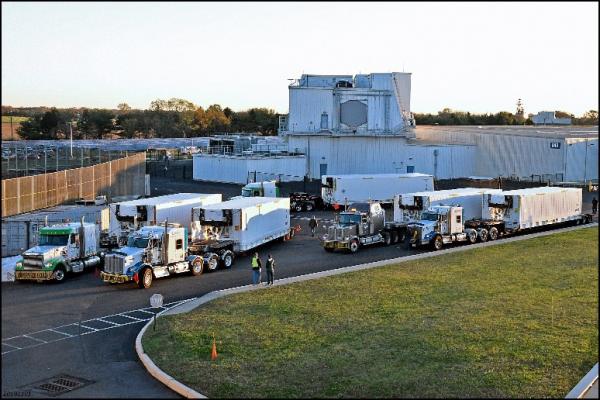Releases

CLEAR, ALASKA and MOORESTOWN, N.J., MARCH 10, 2020 – The Missile Defense Agency’s (MDA) Long Range Discrimination Radar (LRDR) program has completed delivery of the first ten antenna panels to Clear, Alaska, that will make up the first of the system’s two radar antenna arrays. Lockheed Martin (NYSE: LMT) continues to successfully achieve all program milestones as it works towards delivering the radar to MDA in 2020. The system will serve as a critical sensor within MDA’s layered defense strategy to protect the U.S. homeland from ballistic missile attacks.
The two radar antenna arrays will be comprised of a total of 20 panels, each about 27 feet tall, measuring approximately four stories high and wide. Temporary structures have been assembled in front of the radar facility to ensure the panels are installed on schedule, regardless of weather conditions. The installation and integration of the radar system began last year and will be followed by the transition to the testing period.
Over 66% of program technical requirements have already been verified at Lockheed Martin’s Solid State Radar Integration Site (SSRIS). “We are confident in our product because of the extensive testing that we have been able to perform in the SSRIS over the past few years with production hardware and tactical software. We have successfully reduced a large amount of risk to ensure fielding of this critical capability on schedule in 2020,” says Chandra Marshall, director of Lockheed Martin’s Missile Defense and Space Surveillance Radar programs.
In 2018, LRDR achieved Technical Readiness Level 7 using a scalable and modular gallium nitride based “subarray” radar building block, providing advanced performance and increased efficiency and reliability to pace ever-evolving threats. Scaled versions of the LRDR technology will be utilized for future radar programs including Aegis Ashore Japan, recently designated AN/SPY-7(V)1, Canadian Surface Combatant, and Spain’s F-110 Frigate program.
LRDR combines proven solid state radar (SSR) technologies with proven ballistic missile defense algorithms, all based upon an open architecture platform capable of meeting future growth. The system will provide around-the-clock threat acquisition, tracking and discrimination data to enable defense systems to lock on and engage ballistic missile threats.
Lockheed Martin Missile Defense
The LRDR program is built upon S-Band radar technology and is the latest in a long line of S-Band radars developed by Lockheed Martin, including the Aegis Combat System, Space Fence and Aegis Ashore. Lockheed Martin has demonstrated its commitment to advancing SSR technology and addressing emerging and evolving threats.
As a proven world leader in systems integration and development of air and missile defense systems and technologies, Lockheed Martin delivers high-quality missile defense solutions that protect citizens, critical assets and deployed forces from current and future threats. The company’s experience spans missile design and production, hit-to-kill capabilities, infrared seekers, command and control/battle management, communications, precision pointing and tracking optics, radar and signal processing as well as threat-representative targets for missile defense tests
For more information visit https://lockheedmartin.com/en-us/products/long-range-discrimination-radar.html
About Lockheed Martin
Headquartered in Bethesda, Maryland, Lockheed Martin is a global security and aerospace company that employs approximately 110,000 people worldwide and is principally engaged in the research, design, development, manufacture, integration and sustainment of advanced technology systems, products and services.


